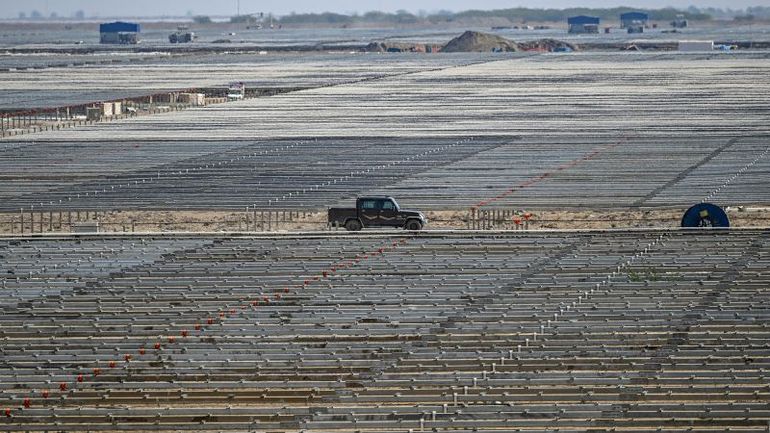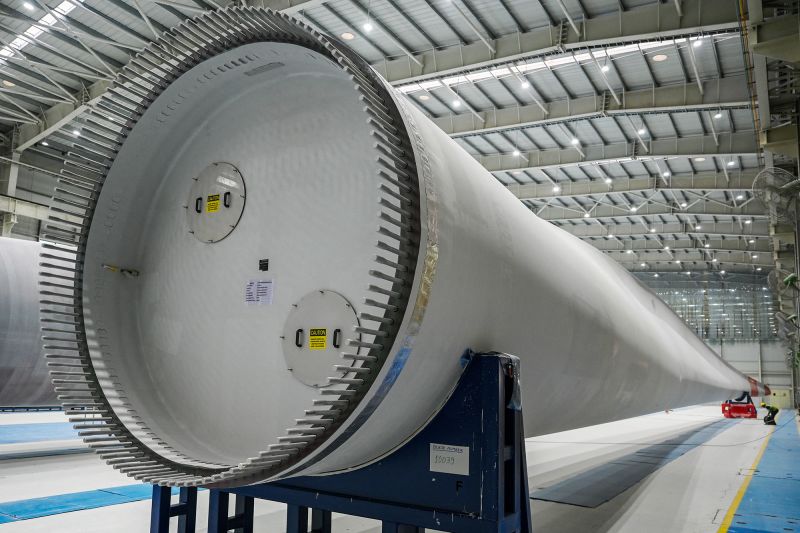
Billionaire's Vision: Unveiling the Massive Clean Energy Plant Five Times the Size of Paris

Explore the remarkable endeavor reshaping vast salt deserts in western India into a prominent hub of clean energy, marking a significant milestone in global sustainability. The sheer magnitude of this transformative project has the leader overwhelmed by its scale and impact.
The project is five times the size of Paris and visible from space. It is the world's biggest energy plant, generating enough electricity to power Switzerland.
The transformation of barren salt desert in western India into a major source of clean energy is so massive that the man in charge is struggling to keep up.
"I don’t even bother with calculations anymore," Sagar Adani mentioned in a recent interview with CNN.
Adani holds the position of executive director at Adani Green Energy Limited (AGEL). He is also the nephew of Gautam Adani, the second wealthiest individual in Asia. The Adani Group, which is India's largest coal importer and a prominent coal miner, has contributed to Gautam Adani's $100 billion fortune. Established in 1988, the conglomerate operates in various sectors such as ports, thermal power plants, media, and cements.
AGEL, a clean energy unit, is constructing a large solar and wind power plant in Gujarat, India, with a budget of around $20 billion. Once completed in approximately five years, it will become the world's largest renewable park, capable of supplying clean electricity to 16 million Indian households.
The success of the Khavda Renewable Energy Park is crucial for India's goal of reducing pollution and achieving its climate targets, while also meeting the increasing energy demands of the country. Despite this, coal still makes up 70% of the electricity produced in India.
An employee working on a blade for a wind turbine produced at an Adani Group factory in the Indian city of Mundra.
An employee working on a blade for a wind turbine produced at an Adani Group factory in the Indian city of Mundra.
Located only 12 miles away from the highly volatile border between India and Pakistan, the park is set to span over 200 square miles and become the world's largest power plant, regardless of the energy source, as stated by AGEL.
Adani stated that the region is vast, untouched by wildlife, vegetation, or human habitation, making it ideal for their plans.
Despite facing challenges since January 2023, when Hindenburg Research accused them of fraud, the group remains committed to their environmental goals.
The Indian mining-to-media conglomerate dismissed Hindenburg's report as "baseless" and "malicious." However, this did not prevent a significant stock market downturn that saw over $100 billion in value lost from its listed companies. Gautam Adani's own wealth also took a hit, dropping by more than $80 billion in the month after the report was published.
Despite this setback, the tycoon has made a recovery, with the group now investing billions in the clean energy industry.
It plans to invest $100 billion into energy transition over the next decade, with 70% of the investments ear-marked for clean energy.
A necessity for 1.4 billion people
Adani Group is shifting towards clean energy, aligning with India's ambitious climate goals. Prime Minister Narendra Modi aims for 50% of India's energy needs to be met by renewable sources like solar and wind power by the end of this decade.
Modi also committed to achieving net zero emissions for India by 2070, a target set a few decades later than developed economies.
The government has a goal of reaching 500 gigawatts (GW) of non-fossil fuel electricity capacity by 2030. AGEL, which is the biggest renewable energy company in the country, plans to contribute at least 9% towards this target. A significant portion of this, almost 30 GW, will come from its Khavda park in Gujarat.
Adani emphasized that there is no choice but to switch to renewable energy.
“There is no choice for India but to start doing things at a previously unimagined size and scale,” the 30-year-old said.
An employee inspecting solar panels at an Adani Group factory in Mundra.
An employee inspecting solar panels at an Adani Group factory in Mundra.
Punit Paranjpe/AFP/Getty Images
Energy demand is projected to increase significantly in the upcoming years.
According to data from the Paris-based International Energy Agency (IEA), India ranks as the world's third-largest consumer of energy. Despite this, the country's energy consumption and emissions per person are less than half of the global average.
Energy demand has doubled since 2000, primarily met by coal, oil, and solid biomass, due to rising incomes. The International Energy Agency predicts that India will experience the largest growth in energy demand globally over the next thirty years.
Adani warned that if India follows the path of countries like China, Europe, and the US in heavily relying on fossil fuels for development, the future consequences for the climate could be dire.
Analysts are optimistic about India's growth prospects, predicting a steady annual rate of at least 6% in the coming years. They believe that India has the potential to become the world's third largest economy by the end of this decade.
As India continues to develop and modernize, its urban population is expected to increase significantly. This will result in a surge in the construction of homes, offices, shops, and other buildings. According to analysts, India is projected to add the equivalent of a city the size of London to its urban population every year for the next three decades.
Electricity demand is projected to increase significantly in the future due to various factors such as better living conditions and climate change. In India, deadly heatwaves have been on the rise, leading to a surge in the ownership of air conditioners.
According to the IEA, by 2050, the total electricity demand from residential air conditioners in India is expected to surpass the current energy consumption of the entire continent of Africa.
India's growing energy needs cannot be met solely by fossil fuels without causing detrimental impacts on efforts to combat climate change. Adani warned that adding 800 GW of coal-fired thermal capacity could overshadow all other sustainable energy projects worldwide in terms of carbon emissions.
A worker walking past rows of solar panels at the Khavda Renewable Energy Park.
A worker walking past rows of solar panels at the Khavda Renewable Energy Park.
Punit Paranjpe/AFP/Getty Images
Both sides of the street
The conglomerate's green initiatives are commendable, but climate experts are concerned about its significant investments in fossil fuels.
According to Tim Buckley, director of Sydney's Climate Energy Finance think tank, "[Gautam] Adani is still investing heavily in fossil fuels despite his green efforts."
The Adani Group is known for being one of the biggest coal mine developers and operators in India. They also manage the contentious Carmichael Coal Mine in Australia. This mine has sparked strong opposition from climate activists who believe it poses a serious threat to the Great Barrier Reef.
According to Buckley, it would be more beneficial for India if Adani focused all their efforts and investments on creating affordable zero-emission technologies instead of investing in new fossil fuel projects.
That is not an option at the moment, said Adani.
Another view of the Khavda Renewable Energy Park
Another view of the Khavda Renewable Energy Park
Punit Paranjpe/AFP/Getty Images
Over the next decade or so, more than 600 million people in India are expected to move into the middle and upper income brackets. It is crucial that they have access to basic energy needs.
While it would be ideal to have 100% of energy coming from sustainable sources, that is not currently feasible.
Adani also mentioned that activists in developed countries, who have been major contributors to greenhouse gas emissions in the past, may not fully grasp the immense task India faces in balancing economic growth with the development of its clean energy sector.
He emphasized the importance of acknowledging that each country has the right to prioritize the well-being of its own citizens in terms of energy resources.
“So is India doing a bit of coal? Yes, of course India is. But is India doing a massive amount of renewables? Yes, there’s no question,” he added
Editor's P/S:
The article highlights the ambitious clean energy project undertaken by Adani Group in India, aiming to transform a barren salt desert into a major source of renewable energy. The scale of the project is truly impressive, with the potential to become the world's largest renewable park and contribute significantly to India's climate goals. However, concerns arise regarding the group's continued investments in fossil fuels, which raise questions about the balance between economic development and environmental sustainability.
India's rapidly growing population and increasing energy demands necessitate a shift towards renewable energy sources. The government's ambitious targets for clean energy capacity and net-zero emissions are commendable. The Adani Group's Khavda Renewable Energy Park is a crucial step in this direction. Yet, the group's involvement in fossil fuel projects, including the controversial Carmichael Coal Mine, raises concerns about their commitment to a sustainable future. Critics argue that the group should prioritize zero-emission technologies over investments in new fossil fuel projects. Balancing economic growth with environmental protection is a complex challenge, and India's approach will be closely monitored as it strives to meet the energy needs of its growing population while addressing climate change.










